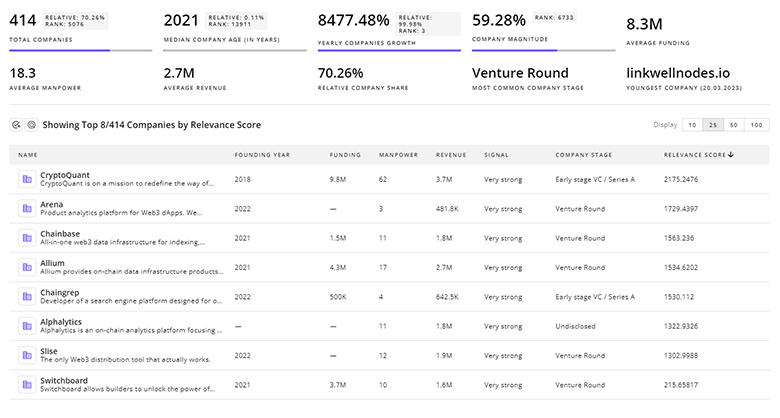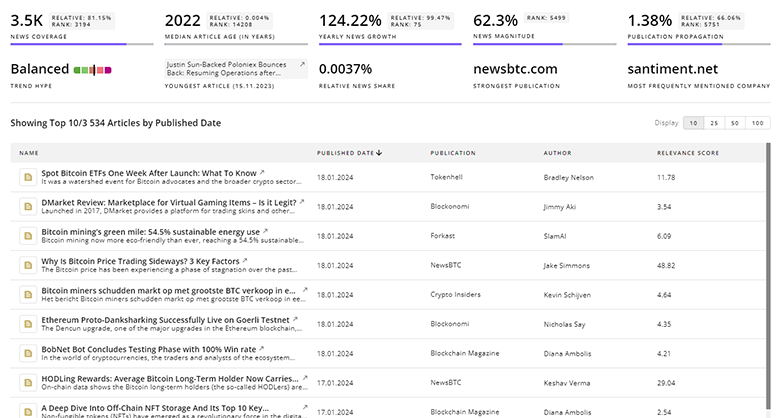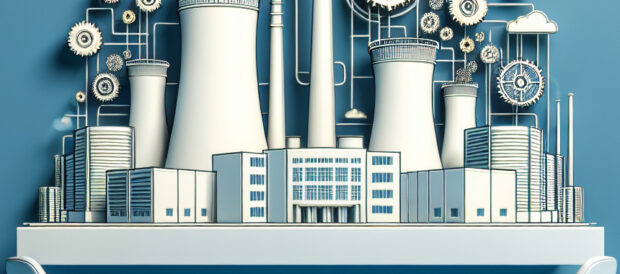
Smart Appliances Report
: Analysis on the Market, Trends, and TechnologiesThe smart appliances market is shifting from connected novelty to AI-driven services, led by a projected industry growth trajectory with an 11.9% CAGR reported in the internal smart appliances trend data. Companies that integrate on-device intelligence, energy management, and subscription services capture the fastest value, while mounting regulation on energy efficiency and data privacy forces product redesign and longer software support cycles.
4 days ago, we last updated this report. Notice something that’s not right? Let’s fix it together.
Topic Dominance Index of Smart Appliances
To gauge the influence of Smart Appliances within the technological landscape, the Dominance Index analyzes trends from published articles, newly established companies, and global search activity
Key Activities and Applications
- Home automation and unified control platforms — remote control, scene orchestration, voice integration and white-label platforms for builders and service providers are core activity areas Flick Automations INNEXIA.
- Energy management and load optimisation — appliances act as flexible loads for demand-response, energy monitoring, and on-site efficiency interventions that reduce utility costs and support sustainability goals.
- Predictive maintenance and service orchestration — sensor telemetry plus AI pre-diagnosis reduces downtime and converts repairs into recurring revenue through service platforms and technician funnels.
- AI-assisted kitchen experiences and automation — guided recipes, automated cooking cycles, and compact robotic chefs expand convenience and generate new product categories for smart kitchens.
- Circularity, reuse and appliance-as-a-service — subscription and refurbishment models extend product life, reduce e-waste, and create steady service margin streams Top Five Trends in Small Appliances.
Emergent Trends and Core Insights
- AI as the principal differentiator — AI is moving from marketing label to product architecture, enabling personalization, predictive maintenance, and home-level energy coordination Top Five Trends in Major Appliances Smart Home Appliances Market 2025: Detailed Insights into Market Size and Future Growth.
- Servitisation and subscription economics — vendors shift from one-time sales to recurring revenue via subscriptions for appliances, maintenance and consumables; large incumbents report rapid growth in subscription revenue and new entrants are building SLaaS offers.
- Converging sustainability and automation — incremental hardware efficiency is reaching physical limits; the next meaningful energy gains come from AI-driven scheduling, heat recovery, and system-level coordination across appliances.
- Interoperability and standard adoption — Matter, Thread and open IoT stacks reduce friction for ecosystem play and accelerate cross-brand services; vendors that adopt open standards reduce customer switching friction.
- Edge-first privacy and local AI — demand for local processing and privacy-preserving features increases for sensitive functions such as food inventory, health monitoring and voice control; companies offering local-only modes can differentiate on trust Snow Smartyz.
- Robotics and embedded automation in kitchens — compact robotic chefs and modular cooking robots move from prototypes to early commercial offerings, creating high-margin appliance categories and integration opportunities with food and meal services HAURA Srl Chefee.
Market-forecast synthesis and interpretation:
– Internal trend data reports a market CAGR of 11.9% for smart appliances. Market sources vary by scope and horizon: an industry forecast cites a global smart appliances CAGR estimates range from ~5.9% (longer-term conservative view for some smart-home segments) to ~14% (higher-growth smart-home forecasts), reflecting differences in segment coverage (smart kitchen vs full smart-home systems), base years and geographic scope Smart Home Appliances Market Size, Share, Competitive Landscape and Trend Analysis Report, 2024-2034 Smart Home Appliances – Market Share Analysis, Growth Forecasts (2025 – 2030). So what: plan using the internal CAGR (11.9%) as your investment-case baseline while stress-testing outcomes against lower and higher external scenarios to reflect regional rollout and product scope differences.
Technologies and Methodologies
- Edge AI and on-device inference for responsive control and privacy-preserving personalization — reduces cloud dependency and latency for real-time cooking and HVAC adjustments.
- Interoperable connectivity stacks — Wi-Fi, Bluetooth, Zigbee plus Matter and Thread for cross-vendor orchestration and simplified installations Hommi.
- Sensor fusion and machine vision — internal cameras, weight sensors and spectroscopy enable inventory tracking, food recognition and cook-state monitoring that feed AI recipe and safety functions.
- Digital twins and remote diagnostics — virtual replicas of appliances accelerate predictive maintenance and allow manufacturers to offer evidence-based Service Level Agreements.
- OTA update frameworks and long-term software support — critical for security patches, new services and enabling servitisation; longer support windows increase consumer trust and lifecycle value.
- Energy orchestration algorithms — home-level schedulers, tariff-aware load shifting and heat-recovery integration deliver measured energy savings and grid value WattSmart Innovations, Inc Ecostella.
Smart Appliances Funding
A total of 137 Smart Appliances companies have received funding.
Overall, Smart Appliances companies have raised $5.7B.
Companies within the Smart Appliances domain have secured capital from 506 funding rounds.
The chart shows the funding trendline of Smart Appliances companies over the last 5 years
Smart Appliances Companies
- Fixle
Fixle operates a home intelligence platform that centralizes appliance manuals, maintenance history and recall alerts into homeowner and pro-focused apps, converting passive ownership into proactive care and service opportunities. The platform supports enterprise integrations that enable insurers, warranty providers and property managers to access property-specific data, making it easier to monetize maintenance and reduce claim costs. Fixle’s positioning targets the service layer between appliances and end users, increasing attachment rates for recurring service products. - Repflow
Repflow builds an AI repair ecosystem that pre-diagnoses appliance faults through multimodal inputs (text, audio, imagery), routing accurate repair guidance to technicians and consumers and reducing unnecessary service visits. The startup’s focus on multilingual, enterprise-grade diagnostics addresses after-sales cost reduction and improves first-time-fix rates for manufacturers and retailers. This capability maps directly into servitisation use cases where predictive alerts convert into scheduled field service contracts. - upliance.ai
upliance.ai offers an AI-powered cooking appliance with guided recipes, integrated weighing and touchscreen guidance targeted at both novice and experienced cooks. The product bundles hardware, a recipe platform and cloud services to create an experience-driven appliance that raises attachment rates for consumables and premium recipe subscriptions. As an India-based scaleup with seed funding and product traction, upliance.ai exemplifies the AI-assisted kitchen segment’s move to combine UX and data monetization. - Levande Subscription & Services
Levande offers appliance subscriptions that include installation, maintenance and replacement guarantees, reducing upfront cost barriers and enabling circular ownership through refurbishment and redeployment. The partnership with a major appliance OEM (Electrolux) shows the commercial model for appliance-as-a-service and its ability to lower churn while creating steady recurring revenue. - Greentech
Greentech focuses on energy-recycling appliances and indoor-air quality devices such as heat-recovery water heaters and CO2-removing kitchen vents, positioning product differentiation around measurable savings and health outcomes. The product set targets eco-conscious homeowners and specification channels that prioritize regulatory compliance and building-level sustainability metrics. Their approach illustrates how energy-focused appliance startups can combine product innovation with quantifiable ROI to enable utility partnerships and incentive programs.
Get detailed analytics and profiles on 949 companies driving change in Smart Appliances, enabling you to make informed strategic decisions.

949 Smart Appliances Companies
Discover Smart Appliances Companies, their Funding, Manpower, Revenues, Stages, and much more
Smart Appliances Investors
TrendFeedr’s Investors tool provides an extensive overview of 597 Smart Appliances investors and their activities. By analyzing funding rounds and market trends, this tool equips you with the knowledge to make strategic investment decisions in the Smart Appliances sector.

597 Smart Appliances Investors
Discover Smart Appliances Investors, Funding Rounds, Invested Amounts, and Funding Growth
Smart Appliances News
Explore the evolution and current state of Smart Appliances with TrendFeedr’s News feature. Access 3.7K Smart Appliances articles that provide comprehensive insights into market trends and technological advancements.

3.7K Smart Appliances News Articles
Discover Latest Smart Appliances Articles, News Magnitude, Publication Propagation, Yearly Growth, and Strongest Publications
Executive Summary
AI, energy orchestration and service models define where commercial value concentrates in smart appliances over the next five years. Use the internal CAGR (11.9%) as your planning baseline while stress-testing for geography and segment variation shown in external forecasts. Prioritize three practical moves: (1) design for on-device intelligence and long software support to protect product lifecycles and data value, (2) build service propositions that convert diagnostics and maintenance into subscriptions, and (3) adopt open connectivity standards and measurable energy features to access utility programs and regulatory incentives. These steps position product teams and investors to capture recurring revenue, reduce total cost of ownership for users, and meet tightening policy requirements without depending on incremental hardware efficiency alone.
We're looking to collaborate with knowledgeable insiders to enhance our analysis of trends and tech. Join us!













